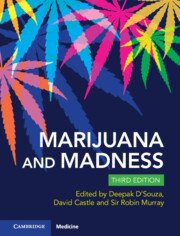332 results
Chapter 5.2 - Causes and Outcome of Psychosis
-
-
- Book:
- Seminars in General Adult Psychiatry
- Published online:
- 04 April 2024
- Print publication:
- 18 April 2024, pp 224-240
-
- Chapter
- Export citation
The effects of exposure and explicit stereotypes on veracity judgments of Polish-accented English speech: A preregistered close replication and extension of Boduch-Grabka & Lev-Ari (2021)
-
- Journal:
- Studies in Second Language Acquisition , First View
- Published online by Cambridge University Press:
- 22 March 2024, pp. 1-17
-
- Article
-
- You have access
- Open access
- HTML
- Export citation
Variation of subclinical psychosis across 16 sites in Europe and Brazil: findings from the multi-national EU-GEI study
-
- Journal:
- Psychological Medicine , First View
- Published online by Cambridge University Press:
- 30 January 2024, pp. 1-14
-
- Article
-
- You have access
- Open access
- HTML
- Export citation
Contributors
-
- Book:
- Marijuana and Madness
- Published online:
- 12 May 2023
- Print publication:
- 01 June 2023, pp vii-x
-
- Chapter
- Export citation
Index
-
- Book:
- Marijuana and Madness
- Published online:
- 12 May 2023
- Print publication:
- 01 June 2023, pp 357-366
-
- Chapter
- Export citation
Part V - Cannabis and Psychosis
-
- Book:
- Marijuana and Madness
- Published online:
- 12 May 2023
- Print publication:
- 01 June 2023, pp 139-166
-
- Chapter
- Export citation
Part II - The Changing Face of Cannabis
-
- Book:
- Marijuana and Madness
- Published online:
- 12 May 2023
- Print publication:
- 01 June 2023, pp 31-60
-
- Chapter
- Export citation
Copyright page
-
- Book:
- Marijuana and Madness
- Published online:
- 12 May 2023
- Print publication:
- 01 June 2023, pp iv-iv
-
- Chapter
- Export citation
Part VII - Cannabinoids and Schizophrenia: Aetiopathology and Treatment Implications
-
- Book:
- Marijuana and Madness
- Published online:
- 12 May 2023
- Print publication:
- 01 June 2023, pp 225-266
-
- Chapter
- Export citation
Part IV - Cannabis, Anxiety, and Mood
-
- Book:
- Marijuana and Madness
- Published online:
- 12 May 2023
- Print publication:
- 01 June 2023, pp 107-138
-
- Chapter
- Export citation
Part VIII - Special Topics
-
- Book:
- Marijuana and Madness
- Published online:
- 12 May 2023
- Print publication:
- 01 June 2023, pp 267-356
-
- Chapter
- Export citation
Part III - Cannabis and the Brain
-
- Book:
- Marijuana and Madness
- Published online:
- 12 May 2023
- Print publication:
- 01 June 2023, pp 61-106
-
- Chapter
- Export citation
Part VI - Cannabinoids and Schizophrenia: Aetiopathology and Treatment Implications
-
- Book:
- Marijuana and Madness
- Published online:
- 12 May 2023
- Print publication:
- 01 June 2023, pp 167-224
-
- Chapter
- Export citation
Contents
-
- Book:
- Marijuana and Madness
- Published online:
- 12 May 2023
- Print publication:
- 01 June 2023, pp v-vi
-
- Chapter
- Export citation
Part I - Pharmacology of Cannabis and the Endocannabinoid System
-
- Book:
- Marijuana and Madness
- Published online:
- 12 May 2023
- Print publication:
- 01 June 2023, pp 1-30
-
- Chapter
- Export citation
Chapter 17 - Does Cannabis Cause Psychosis?
- from Part VI - Cannabinoids and Schizophrenia: Aetiopathology and Treatment Implications
-
-
- Book:
- Marijuana and Madness
- Published online:
- 12 May 2023
- Print publication:
- 01 June 2023, pp 167-177
-
- Chapter
- Export citation
Chapter 15 - Which Cannabis Users Develop Psychosis?
- from Part V - Cannabis and Psychosis
-
-
- Book:
- Marijuana and Madness
- Published online:
- 12 May 2023
- Print publication:
- 01 June 2023, pp 148-155
-
- Chapter
- Export citation
Chapter 26 - Cannabis Use and Violence
- from Part VIII - Special Topics
-
-
- Book:
- Marijuana and Madness
- Published online:
- 12 May 2023
- Print publication:
- 01 June 2023, pp 279-284
-
- Chapter
- Export citation
Preface
-
- Book:
- Marijuana and Madness
- Published online:
- 12 May 2023
- Print publication:
- 01 June 2023, pp xi-xii
-
- Chapter
- Export citation

Marijuana and Madness
-
- Published online:
- 12 May 2023
- Print publication:
- 01 June 2023



